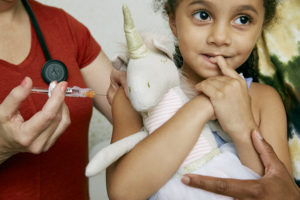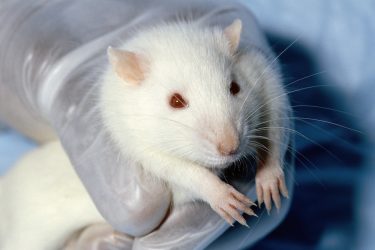
Photos accompanying news stories about vaccines are notoriously awful, both in effect and in verisimilitude. They often feature large needles that have little resemblance to the actual needles used to administer immunizations.
Or they are real images but feature an utterly terrified child screaming as though Satan himself were injecting demon blood into their veins. (Note: Most vaccines are administered into the muscle, not the bloodstream.)
There are many reasons these photos are used — more on that below — but one reason is a dearth of freely available, high-quality images not featuring screaming kids. Self Magazine has teamed up with the American Academy of Pediatrics to create an online library of images that takes away that excuse. And anyone can download and use them, for free. The project is part of Self’s “Vaccines Save Lives” package.
This is a fantastic new resource, and I hope every news organization takes advantage of it. I have a good idea of how many bad images are out there because I co-authored a study last year with University of Minnesota researchers in PLOS ONE that took a scholarly approach to assess vaccine imagery in news media. I had proposed the idea to the senior author because I’d already been evangelizing about the need for better vaccine photos for years, and I certainly wasn’t the only one.
One of the first to point out the problem with vaccine imagery was Glendon Mellow on his Scientific American Symbiartic blog post, “Pro-Vaccine Communication: You’re Doing it Wrong.” I was thrilled when I saw his post: I can’t control all images used for my stories, but had some control for certain stories and always sought out appropriate photos when I could — anything that emphasized health or portrayed immunization without giant needles, tears or screams. I often asked my editors to choose photos without big needles and screams. (Sometimes they honored my request, sometimes they didn’t.)
Mellow, myself and Panic Virus author Seth Mnookin were among an increasingly vocal group especially on social media. Sometimes these critiques happily led to a change in photos, but frustratingly we more often continued to see fear-mongering photos that eroded the value and credibility of the news story.
While some children do scream and cry when they get a vaccine, many don’t. Using only negative imagery with vaccine-related stories is ethically questionable for two reasons: First, it doesn’t accurately represent vaccination if no positive images are ever used (since so many children, teens and adults don’t scream or cry). Second, it promotes fear and negativity with one of humanity’s most important public health achievements, inaccurately suggesting less benefit to immunizations than the evidence shows.
So why would these images get used so often? I have a few hypotheses. (My master’s degree is in photojournalism, so I think a lot about images anyway.) One is the simple “it bleeds, it leads” problem. Screams and needles are dramatic; editors may subconsciously gravitate toward images with more emotion and drama. Another is a personal unconscious bias: if we associate vaccines with pain, we might be more inclined to pick those images because of availability bias and confirmation bias. But another undeniable reason is how limited the options are. I sometimes reused the same photos to avoid the inaccurate or fear-mongering ones, which was frustrating.
That’s why I’m thrilled to see the images Self created and is sharing. “We wanted to create stock photography about getting vaccinated that is medically accurate, realistic, and not fear-mongering,” wrote Casey Gueren in the article unveiling the new images. And they were serious about medical accuracy: “We then invited an AAP-affiliated physician to join us on set, to help make sure in real-time that the images we were capturing reflected reality,” Gueren wrote. “Then after the shoot we worked with the AAP to choose the final selection of images, eliminating pictures that didn’t meet their high standards. The AAP held us accountable for creating images that are not just relatable and beautiful but also accurate.”
Self also addressed another problem not just with vaccine images but stock photography in general — their unbearable whiteness of being. “As with all Self original stock photos, we wanted to make sure the images were inclusive so that our readers can see themselves represented in our content,” Gueren wrote. Indeed, the images include people of all sizes, colors, ethnicities, ages, body types, faiths, genders and other identities. Now it’s just a matter of news organizations choosing to use this trove of new images.









